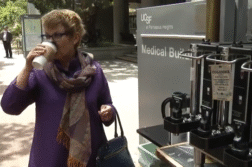SAN DIEGO, Calif. (Ivanhoe Newswire) – Hodgkin lymphoma is a cancer of the immune system. It mostly strikes people in the prime of their lives – between 20 and 40 years old – and is usually treated with chemo and radiation. Now, a new treatment is turning the body against the deadly cells – giving more hope to more people battling this disease to be cancer-free.
From basketball to ballet, Georgie Garabet knows to be a good dad to Sophia and Jude, he’d need to know a little bit about a lot. At just 43, he didn’t expect he’d have to do a crash course on cancer.
Georgie says, “I didn’t know what lymphoma was until they told me I had it.”
One of the first signs — an uncontrollable itch.
“I had to sleep standing up, sometimes. I couldn’t lay down. It was so bad,” Georgie painfully recalls.
Weight loss was quick and extreme.
“I’m usually around 245, 250. I got down to 170-ish,” he tells Ivanhoe.
Georgie was diagnosed with stage three Hodgkin lymphoma. He immediately enrolled in a phase three clinical trial at City of Hope that combines chemo with Nivolumab, an antibody that tracks down the cancer hiding in the body and calls on the immune system to attack. After one year of treatment, 94 percent of patients were cancer-free, compared to 86 percent treated with the current standard of care, Brentuximab. Less than one percent needed follow up radiation treatment.
“Patients were twice as likely to have a relapse or disease progression if they were in the brentuximab arm. So, it was a huge improvement,” explains Hematologist at City of Hope, Alex Herrera, MD.
After his fourth infusion, Georgie was told there was no trace of lymphoma in his body. Two years later – still no sign. His focus now, entirely on his children. Cancer-free
Dr. Herrera says the next steps include following the almost one thousand patients in the trial. They hope to apply to the FDA by the end of this trial to make this treatment the standard of care for all stage three and four Hodgkin lymphoma patients.
Contributors to this news report include: Marsha Lewis, Producer; Matt Goldschmidt, Videographer; Roque Correa, Editor.
To receive a free weekly e-mail on medical breakthroughs from Ivanhoe, sign up at: http://www.ivanhoe.com/ftk
MEDICAL BREAKTHROUGHS
RESEARCH SUMMARY
TITLE: BREAKTHROUGH TREATMENT MAKES DAD CANCER-FREE
REPORT: MB #5390
BACKGROUND: Hodgkin lymphoma, also known as Hodgkin’s disease, is a type of lymphoma that typically involves the lymph nodes but can also affect other organs and tissues. It is a relatively rare form of cancer. It accounts for approximately 10 percent of all lymphomas. The global incidence rate of Hodgkin lymphoma is about two to three cases per 100,000 people per year. Incidence rates vary by region and age group. It has a bimodal age distribution, with one peak in young adults, ages 15 to 35, and another peak in older adults ages 55 and older. In general, Hodgkin lymphoma is slightly more common in males than females. The two subtypes of the disease are the most common subtype, classical Hodgkin lymphoma, which accounts for approximately 95 percent of cases, and the more rare subtype, nodular lymphocyte-predominant Hodgkin lymphoma, which accounts for five percent of cases.
(Sources: https://www.mayoclinic.org/diseases-conditions/hodgkins-lymphoma/symptoms-causes/syc-20352646
https://www.lls.org/lymphoma/hodgkin-lymphoma/diagnosis/hodgkin-lymphoma-subtypes
DIAGNOSING: Diagnosing Hodgkin lymphoma involves a combination of medical history evaluation, physical examination, imaging tests, and tissue biopsy to accurately identify the disease and its stage. Diagnosis always begins by gathering information about the patient’s symptoms, such as persistent swelling of the lymph nodes, fatigue, weight loss, night sweats, and fever. A doctor then examines the patient for enlarged lymph nodes, usually in the neck, underarms, or groin. The provider may also check for an enlarged spleen or liver. Imaging tests help to visualize the lymph nodes and other organs to identify any abnormalities. Next, A tissue biopsy is essential for confirming a diagnosis of Hodgkin lymphoma. After confirming the diagnosis, staging tests are performed to determine the extent of the disease. Once the diagnosis is confirmed, additional tests are conducted to stage the disease and determine the best course of treatment. Early and accurate diagnosis is crucial for effective management and treatment of Hodgkin lymphoma.
(Sources: https://www.cancer.org/cancer/types/hodgkin-lymphoma/detection-diagnosis-staging/staging.html
https://www.mayoclinic.org/diseases-conditions/hodgkins-lymphoma/diagnosis-treatment/drc-20352650
NEW TECHNOLOGY: A new drug called brentuximab vedotin is a new targeted therapy that has been approved as an initial treatment for people with advanced Hodgkin’s lymphoma. The use of this new drug could help older patients to avoid what had previously been a standard treatment of a toxic chemotherapy drug.
FOR MORE INFORMATION ON THIS REPORT, PLEASE CONTACT:
Letisia Marquez Zen Logsdon
lemarquez@coh.org zlogsdon@coh.org
If this story or any other Ivanhoe story has impacted your life or prompted you or someone you know to seek or change treatments, please let us know by contacting Marjorie Bekaert Thomas at mthomas@ivanhoe.com




